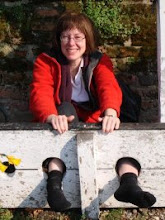
The Welsh cot quilt came from Cardigan in West Wales and measures 33 x 27". It dates from about 1900. It is entirely hand quilted and hand pieced. It is very worn, faded and somewhat stained (must have been used for many small babies!)One side is a pink cotton while the other side is patchwork in a simple frame pattern. This must have been very cheerful and colourful at one time, as it is made from flowered scraps of cotton sateen. These are rather small scraps - even the centre is two pieces set together. Fabrics include a pink paisley, a trellis pattern with purple roses, green and also brown paisleys, a pink lozenge pattern and the central fabric with large cabbage roses.
The interesting thing to see is that the selvages show on either side of the pink cloth (see photo) - showing that it is made from one width of fabric. A common width of fabric at this time was 36" but in this case the measurement is 27" so, perhaps fabric that is 28" wide. We can see that this is clearly a cot quilt, not a fragment of a larger quilt.


This is a Victorian Durham quilt made to fit a baby's cot (I suppose the American term would be a crib quilt), It measures 36 by 30". If you look at the stitching and the frill, the ivory or white side is the top, while the reverse is a pink colour. The stitching is good throughout, with a midweight cotton wadding.
Quilting patterns seen are cross hatching with a central strip with a "worm" pattern. There is a frill or ruffle made from a single layer of cloth. It is joined to the top with two lines of machine stitching. Although not many survive, it was common to have small quilting frames to make these cot quilts and other small quilted items.
Quilting patterns seen are cross hatching with a central strip with a "worm" pattern. There is a frill or ruffle made from a single layer of cloth. It is joined to the top with two lines of machine stitching. Although not many survive, it was common to have small quilting frames to make these cot quilts and other small quilted items.



 Here are two cot quilts - one a Durham and one Welsh.
Here are two cot quilts - one a Durham and one Welsh.
No comments:
Post a Comment